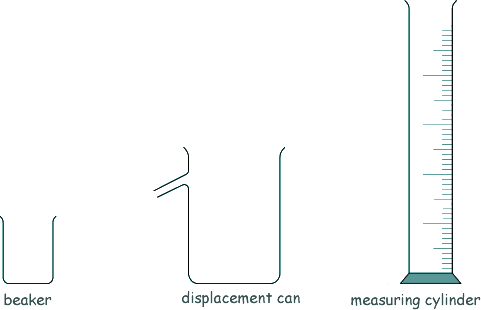Materials: Density
Q4. Barry investigated the density of different fruits.
To determine the density of each fruit, he measured the volume of each fruit.

The diagram above shows the equipment he used.
(a) Describe a method Barry could have used to measure the volume of an orange, using this equipment.

3 - 4 marks |
1 - 2 marks |
| Level 0: |
No relevant content |
0 marks |
Indicative content:
 use the beaker to fill the eureka/displacement can with water
use the beaker to fill the eureka/displacement can with water
 fill the eureka/displacement can up to the spout
fill the eureka/displacement can up to the spout
 put the measuring cylinder in a position so it can collect water coming out of the eureka can spout
put the measuring cylinder in a position so it can collect water coming out of the eureka can spout
 place the orange gently in eureka/displacement can
place the orange gently in eureka/displacement can
 collect water that overflows
collect water that overflows
 measure volume of water collected in the measuring cylinder
measure volume of water collected in the measuring cylinder
 repeat the process
repeat the process
[4 marks]
(b) He measured the volume of each fruit three times and then calculated a mean value.
(i) What are the advantages of taking three measurements and calculating a mean value?
Choose your answer fom the following reasons:
Allows anomalous results to be identified and ignored. |
 |
Improves the resolution of the volume measurement. |
|
Increases the precision of the measured volumes. |
|
Reduces the effect of random errors when using the equipment. |
 |
Stops all types of error when using the equipment. |
|
[2 marks]
(ii) The three measurements for the volume of a grape were 2.1 cm3, 2.1 cm3 and 2.4 cm3.
Calculate the mean value he should use for the grape.

Ignoring the anomoly 2.4 cm3 
the mean value =
(2.1 + 2.1) /2  = 2.1 cm3
= 2.1 cm3
the mean value = (2.1 + 2.1 + 2.4) /3  = 2.2 cm3
= 2.2 cm3
[3 marks]
(c) The mass of an apple was found to be 84.0 g. The volume of the apple was calculated as 120 cm3.
Calculate the density of the apple. Give the answer to the corect number of significant figures.
density = mass/volume 
ρ = m/V
ρ = 84.0/120  = 0.700
= 0.700  g/cm3
g/cm3
[5 marks]
[Total: 14 marks]







